What are the WPS summation formulas?
wps summation formulas are: 1. Area summation "=SUM (condition area)"; 2. Mixed summation "=SUM (condition 1, condition 2...)"; 3. Intersection area Sum “=SUM(condition 1 condition 2)”; 4. Single condition sum “=SUM((condition 1=array 1)*(condition 2))”; 5. Multi-condition sum “=SUM((condition 1=array1)*(condition2=array2)); 6. Nested FILTER function summary sum "=SUM(FILTER(condition1, condition2=array1))".

The operating environment of this tutorial: Windows 10 system, WPS 2009 version, dell g3 computer.
The SUM function is the most commonly used and basic summation function in WPS tables. Format: Usage of the SUM function: SUM (array 1,...) or SUM ((condition area 1 = condition 1) * (condition area 2 = condition 2) *... * summation area); the SUM function returns a certain area The sum of all values in the cell. It can sum the values of cells in continuous or discontinuous areas, and can also sum multiple conditions. The SUM function is a summation function often used in WPS tables.
The specific usage of the SUM function is as follows:
(1) Sum the horizontal continuous areas, as shown in the table below. The area from data 1 to data 4, that is, column C to column F, must be calculated in rows. To perform the sum, in the summing result placement area, enter the formula in cell G3: =SUM(C3:F3). The formula represents the result of adding the values of the four cells C3, D3, E3, and F3.
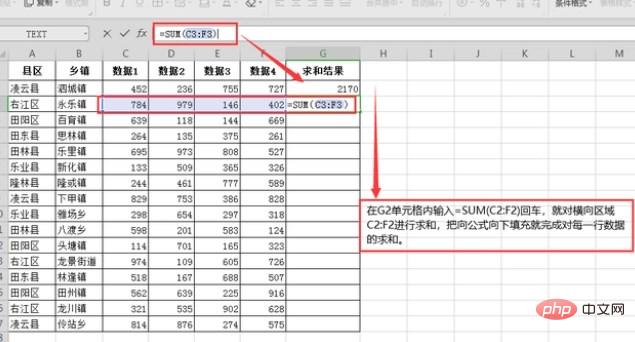
Sum vertically continuous areas. As shown in the table below, the data 1 to data 4 area, that is, column C to column F, must be summed column by column. In the summation result placement area, unit F18 Enter the formula: =SUM(F2:F17). The formula represents the result of adding the values in the vertical cells in rows F2 to F17.

(2) Mixed sum .As shown in the table below, you need to sum the values of the three cells or areas C2, D4:E5, and F8:F11 in the data table. In the area where the summation result is placed, enter the formula in cell I2: =SUM(C2,D4: E5,F8:F11), the formula represents the result of adding the values in the C2, D4:E5, F8:F11 cells and range.
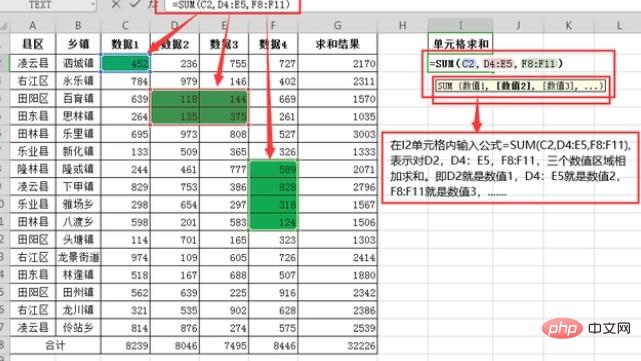
(3) Intersection Area summation. As shown in the table below, the values at the intersection of the C2:E11 area and the D6:G13 area in the data table need to be summed, that is, the values in the blue area are summed. In the area where the summation result is placed, unit I2 Enter the formula: =SUM(C2:E11 D6:G13)). In the formula, the C2:E11 area and the D6:G13 area are separated by spaces. The summation result will be the value of the intersection of the two areas. And.

(4) Single condition sum. As shown in the table below, the data of each county in the data table needs to be summed, that is, the data column 1 is summed. In the summing result placement area, enter the formula in unit J2: =SUM(($A$2:$A$17=I2)*($C$2:$C$17)). In the formula, $A$2:$A$17=I2 is Sum the data in the A2:A17 area that matches I2 and correspond to C2:C17, that is, sum the data in the A2:A17 area that matches the data in Lingyun County.
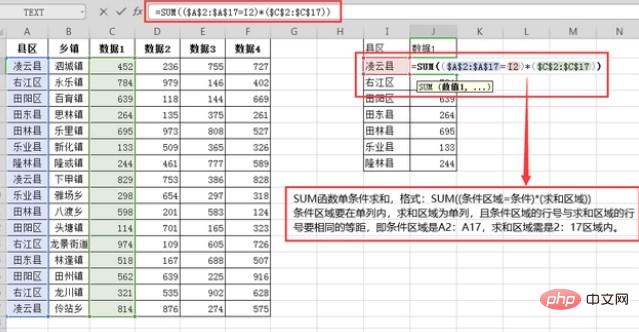
(5) Multi-condition summation. As shown in the table below, the data of each county in the data table needs to be summed, that is, the data column 1 is summed. In the summing result placement area, enter the formula in unit K2: =SUM(($A$2:$A$17=I2)*($B$2:$B$17=J2)*$C$2:$C$17), in the formula $A$2:$A$17=I2 is the sum of the data in the A2:A17 area that matches I2 and $B$2:$B$17=J2 is the sum of the data in the B2:B17 area that matches J2 and corresponds to C2:C17. That is, the data in the A2:A17 and B2:B17 areas are consistent with the data in Sicheng Town, Lingyun County.
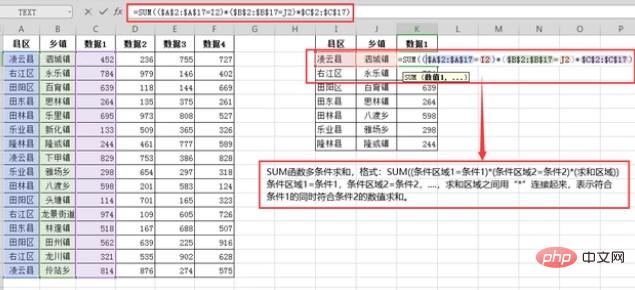
(6) SUM nested FILTER function summary summation. As shown in the table below, the data of each county in the data table must be summarized and summed, that is, the data from column 1 to column 4 must be summarized and summed for all data in a certain county. In the summing result placement area, enter the formula in cell I2: =SUM(FILTER($C$1:$F$17,$A$1:$A$17=H2)), in the formula FILTER($C$1:$F$17, $A$1:$A$17=H2) is to filter out all the data in column A that matches H2. The SUM function is to sum up all the data filtered out by the FILTER function.
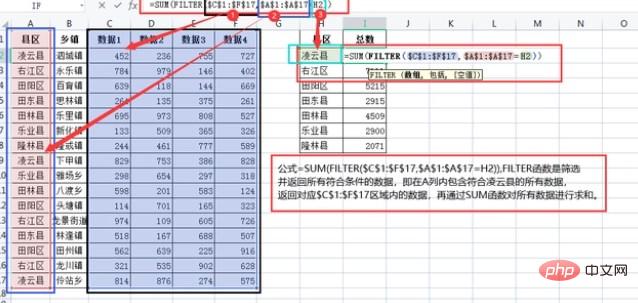
The above is the detailed content of What are the WPS summation formulas?. For more information, please follow other related articles on the PHP Chinese website!

Hot AI Tools

Undresser.AI Undress
AI-powered app for creating realistic nude photos

AI Clothes Remover
Online AI tool for removing clothes from photos.

Undress AI Tool
Undress images for free

Clothoff.io
AI clothes remover

AI Hentai Generator
Generate AI Hentai for free.

Hot Article

Hot Tools

Notepad++7.3.1
Easy-to-use and free code editor

SublimeText3 Chinese version
Chinese version, very easy to use

Zend Studio 13.0.1
Powerful PHP integrated development environment

Dreamweaver CS6
Visual web development tools

SublimeText3 Mac version
God-level code editing software (SublimeText3)

Hot Topics
 1378
1378
 52
52
 WPS and Office do not have Chinese fonts, and Chinese font names are displayed in English.
Jun 19, 2024 am 06:56 AM
WPS and Office do not have Chinese fonts, and Chinese font names are displayed in English.
Jun 19, 2024 am 06:56 AM
My friend's computer, all Chinese fonts such as imitation Song, Kai style, Xing Kai, Microsoft Yahei, etc. cannot be found in WPS and OFFICE. The editor below will tell you how to solve this problem. The fonts in the system are normal, but all fonts in the WPS font options are not available, only cloud fonts. OFFICE only has English fonts, not any Chinese fonts. After installing different versions of WPS, English fonts are available, but there is also no Chinese font. Solution: Control Panel → Categories → Clock, Language, and Region → Change Display Language → (Region and Language) Management → (Language for Non-Unicode Programs) Change System Regional Settings → Chinese (Simplified, China) → Restart. Control Panel, change the view mode in the upper right corner to "Category", Clock, Language and Region, change
 How to use wps translation function_How to use wps translation function
Mar 27, 2024 pm 04:46 PM
How to use wps translation function_How to use wps translation function
Mar 27, 2024 pm 04:46 PM
1. First, we open wpsoffice on the mobile phone. 2. Then click Apply. 3. Click the image to translate. Method 2 1. First, we open wpsoffice on the mobile phone. 2. Open the document that needs to be translated and click the tool in the lower left corner. 3. Click Review and Translate.
 How to center the WPS Word table
Mar 21, 2024 pm 02:21 PM
How to center the WPS Word table
Mar 21, 2024 pm 02:21 PM
When using word in WPS, you often need to insert pictures, tables, etc., but if the inserted table is not centered, it will affect the beauty of the entire document. So how to set the centering of the WPS table? Today I will teach you how to make adjustments. The specific steps are as follows. Come and take a look! 1. The table in the picture is not in the middle of the page, which is not very beautiful. I want it to be centered. 2. First, right-click the mouse in the table (as shown in the picture). 3. Then click [Select All Tables] in the right-click menu (as shown by the red arrow in the figure). 4. After clicking, the table will be fully selected (as shown in the figure below). 5. At this time, click to open the [Start] tab of wps text (as shown by the red arrow in the figure). 6 o'clock
 What should I do if WPS cannot start the printer job?
Mar 20, 2024 am 08:20 AM
What should I do if WPS cannot start the printer job?
Mar 20, 2024 am 08:20 AM
We can use office software to produce various electronic documents. Electronic documents greatly save the use of paper and are easier to save and read. However, sometimes according to work requirements, superiors require printing out paper documents for everyone to circulate. Document writing It's fine but unable to print. It's very difficult to encounter such a situation. The course we brought today can solve this problem. The following lesson is: What should I do if WPS cannot start the printer job? When trying to print a document using a LAN printer, a problem occurred, saying "WPSOffice cannot start the print job. Please check whether the printer is turned on and online." But in fact, the printer is powered on and online. 2. Click "OK", then click on the upper left corner of the title bar as shown in the picture
 How to create a QR code using wps
Mar 28, 2024 am 09:41 AM
How to create a QR code using wps
Mar 28, 2024 am 09:41 AM
1. Open the software and enter the wps text operation interface. 2. Find the insert option in this interface. 3. Click the Insert option and find the QR code option in its editing tool area. 4. Click the QR code option to pop up the QR code dialog box. 5. Select the text option on the left and enter our information in the text box. 6. On the right side, you can set the shape of the QR code and the color of the QR code.
 Why macros still cannot be enabled after wps installs vba
Mar 21, 2024 am 08:30 AM
Why macros still cannot be enabled after wps installs vba
Mar 21, 2024 am 08:30 AM
wpsOffice is an office software suite independently developed by Kingsoft Software Co., Ltd., which can realize multiple functions such as text, forms, presentations, and PDF reading. It has the advantages of low memory usage, fast running speed, multiple cloud functions, powerful plug-in platform support, free massive online storage space and document templates. What the editor will introduce to you today is the "macro" function. In the past few days, friends have always asked me why I still can't enable macros after installing VBA. The "macro" function is still gray and cannot be opened, as shown below. What's going on? The editor will find out the reasons for you. There are three main reasons for this situation: 1. Does your wps support vba? Some versions do not support it. 2. Confirm that you have enabled macros and whether the operation
 Introduction to the method of editing watermark with WPS
Mar 27, 2024 pm 02:06 PM
Introduction to the method of editing watermark with WPS
Mar 27, 2024 pm 02:06 PM
1. We use WPS to open a document. There is a watermark in it. It looks messy. How to remove it? Look down. 2. Find the Insert tab in the menu bar, select the header and footer icons under this tab, and click on them with the left mouse button. 3. At this time, the text on the page becomes gray and cannot be edited, but the watermark on the back of the text can be edited at this time. 4. Click on the watermark, you can see that this is a picture watermark, because there are several small squares around the picture, and the picture can be edited at this time. 5. Use the delete key on the keyboard to delete the picture, and you can see that the watermark is gone. 6. Double-click the mouse on the page to exit the header and footer editing mode. The text on the page returns to normal color and can be edited, but at this time the watermark on the page has disappeared. 7.
 How to set WPS value to automatically change color according to conditions_Steps to set WPS table value to automatically change color according to condition
Mar 27, 2024 pm 07:30 PM
How to set WPS value to automatically change color according to conditions_Steps to set WPS table value to automatically change color according to condition
Mar 27, 2024 pm 07:30 PM
1. Open the worksheet and find the [Start]-[Conditional Formatting] button. 2. Click Column Selection and select the column to which conditional formatting will be added. 3. Click the [Conditional Formatting] button to bring up the option menu. 4. Select [Highlight conditional rules]-[Between]. 5. Fill in the rules: 20, 24, dark green text with dark fill color. 6. After confirmation, the data in the selected column will be colored with corresponding numbers, text, and cell boxes according to the settings. 7. Conditional rules without conflicts can be added repeatedly, but for conflicting rules WPS will replace the previously established conditional rules with the last added rule. 8. Repeatedly add the cell columns after [Between] rules 20-24 and [Less than] 20. 9. If you need to change the rules, you can just clear the rules and then reset the rules.




